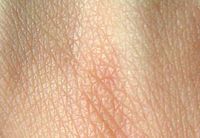
Photo from wikipedia
Physiologically based pharmacokinetic (PBPK) modeling has increasingly been employed in dermal drug development and regulatory assessment, providing a framework to integrate relevant information including drug and drug product attributes, skin… Click to show full abstract
Physiologically based pharmacokinetic (PBPK) modeling has increasingly been employed in dermal drug development and regulatory assessment, providing a framework to integrate relevant information including drug and drug product attributes, skin physiology parameters, and population variability. The current study aimed to develop a stepwise modeling workflow with knowledge gained from modeling in vitro skin permeation testing (IVPT) to describe in vivo exposure of metronidazole locally in the stratum corneum following topical application of complex semisolid drug products. The initial PBPK model of metronidazole in vitro skin permeation was developed using infinite and finite dose aqueous metronidazole solution. Parameters such as stratum corneum lipid-water partition coefficient (Ksclip/water) and stratum corneum lipid diffusion coefficient (Dsclip) of metronidazole were optimized using IVPT data from simple aqueous solutions (infinite) and MetroGel (10 mg/cm2 dose application), respectively. The optimized model, when parameterized with physical and structural characteristics of the drug products, was able to accurately predict the mean cumulative amount permeated (cm2/h) and flux (μg/cm2/h) profiles of metronidazole following application of different doses of MetroGel and MetroCream. Thus, the model was able to capture the impact of differences in drug product microstructure and metamorphosis of the dosage form on in vitro metronidazole permeation. The PBPK model informed by IVPT study data was able to predict the metronidazole amount in the stratum corneum as reported in clinical studies. In summary, the proposed model provides an enhanced understanding of the potential impact of drug product attributes in influencing in vitro skin permeation of metronidazole. Key kinetic parameters derived from modeling the metronidazole IVPT data improved the predictions of the developed PBPK model of in vivo local metronidazole concentrations in the stratum corneum. Overall, this work improves our confidence in the proposed workflow that accounts for drug product attributes and utilizes IVPT data toward improving predictions from advanced modeling and simulation tools.
Journal Title: Molecular pharmaceutics
Year Published: 2022
Link to full text (if available)
Share on Social Media: Sign Up to like & get
recommendations!